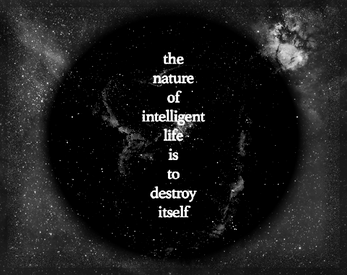the nature of intelligent life is to destroy itself
the nature of intelligent life is to destroy itself
composed, designed, and coded by michael gancz
best experienced with headphones in fullscreen
This is a web-accessible version of my 2022 MA/BA thesis project in music theory at Yale University. The original experience took place in an eight-channel ambisonic (3D audio) array. The array played a short orchestral composition, with different instruments and sections moving around the listener in a manner that, to me, reflected the existential grief of growing up during the climate crisis.
The title refers to the famous Fermi Paradox, posed by Manhattan Project physicist Enrico Fermi: through all the vast potential of the universe it's almost certain there is life resembling our own, but despite our best efforts we have found none. It could be that we are alone, that other life is too advanced or primitive to allow for contact, that our instrumentation just can't reach far enough. It could be a lot of things. It isn't.
In this version of my project, the stems from my ambisonic mix are re-choreographed as objects in a virtual binaural space. My original composition is split into parts, successively unlocked as the player learns to navigate their surroundings. The visual and interactive components of the web medium let me explore a new class of self-destructive themes, expanding the original idea into a story about bodies, identity, and control.
This piece won a 2024 ASCAP Morton Gould Young Composer Award and a 2022 Beekman Cannon Friends Prize. I could not have made it without the Yale Symphony Orchestra, the Yale Center for Collaborative Arts and Media, my advisors at the Yale Music Department, and my volunteer playtesters.
Read more about this piece at https://www.michaelgancz.com/nature/
| Status | In development |
| Platforms | HTML5 |
| Author | studio gamma |
| Made with | Unity |
| Average session | A few minutes |
| Inputs | Keyboard, Mouse |
